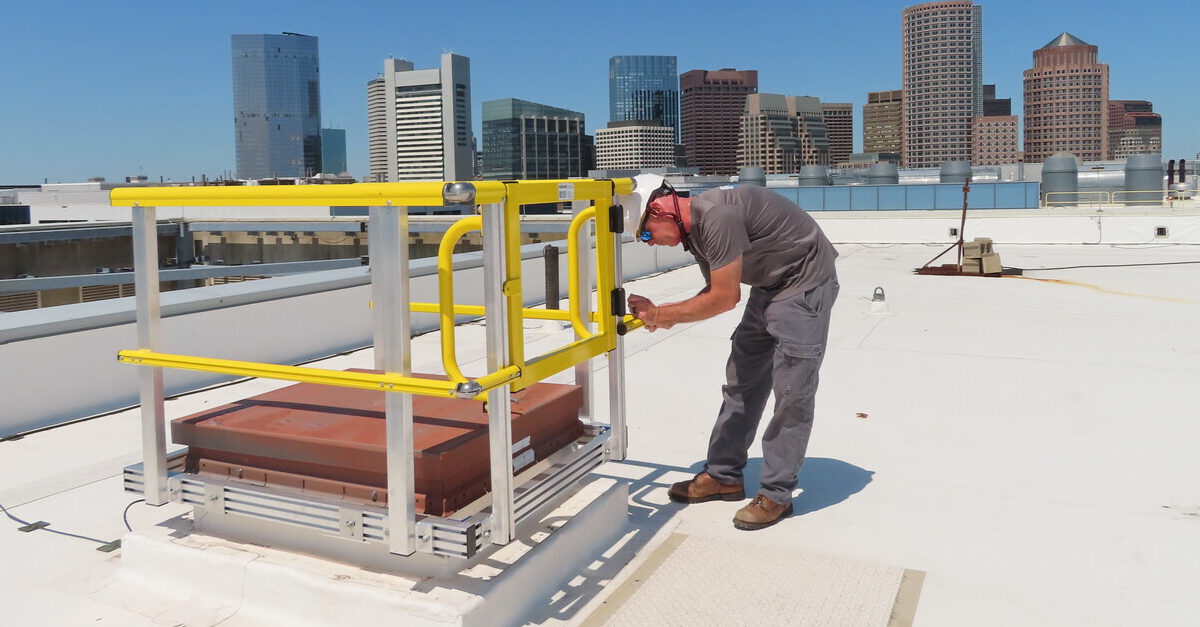
Top OSHA Violations for 2025: Is Your Workplace Compliant?
OSHA violations are more than just paperwork errors — they can cost property teams thousands in fines and, more importantly, put workers at risk. Each year, OSHA releases its list of the most frequently cited standards, offering valuable insight into where safety programs tend to fall short.
For building owners, property managers, building engineers, and maintenance teams, understanding these top violations is an opportunity to strengthen safety practices and prevent costly surprises.
#1 Violation — Fall Protection: General Requirements (1926.501)
Why It Matters
Fall protection consistently ranks as OSHA’s most cited violation — and for good reason. Waterproofing projects, skylight maintenance, rooftop HVAC repairs, and loading dock edges all create daily exposure points across properties. In 2023 alone, 421 construction workers lost their lives to falls, making this not only the most common violation but also one of the most serious.
What Inspectors Look For
OSHA inspectors focus on missing or incomplete guardrails, unprotected skylights, and workers operating at heights without fall protection. They also expect to see a written fall protection plan and documentation showing that every employee has been trained to use fall equipment properly. Missing any of these elements can trigger citations.
Quick Fixes
- Map rooftop and elevated work hazards, including skylights and edges.
- Mark designated safe travel paths and controlled access zones.
- Install temporary or permanent guardrails where needed.
- Use self-retracting lifelines anchored to certified points rated for 5,000 pounds per worker.
- Document all training sessions — inspectors may request to review the records.
- Schedule a rooftop safety audit to confirm compliance and identify risk areas.
#2 Violation — Hazard Communication (1910.1200)
Why It Matters
Chemical safety violations often catch property teams off guard — and they’re frequently found in everyday tasks. Unlabeled spray bottles, cleaning products transferred into secondary containers, and outdated Safety Data Sheets (SDS) binders all create compliance gaps that can lead to costly penalties and safety risks.
What Inspectors Look For
OSHA inspectors expect to see a written Hazard Communication (HazCom) program, current SDS documentation, and proper labeling on every container that holds cleaning supplies, maintenance chemicals, or roof coatings. Missing even one of these elements can trigger citations.
Quick Fixes
- Review and update your written HazCom program annually.
- Label all secondary containers clearly and consistently.
- Maintain up-to-date SDS records and store them in an accessible location.
- Provide annual HazCom training for engineering and janitorial staff.
- Treat every unlabeled container as a potential violation and address it immediately.
#3 Violation — Ladders (1926.1053)
Why It Matters
Portable and fixed ladders are among the most common tools on any property — and among the most frequently cited OSHA violations. Maintenance teams and contractors use them daily for ceiling repairs, mechanical access, and to access the roof, but improper use and poor maintenance make them a persistent safety risk.
What Inspectors Look For
Inspectors note damaged ladders with bent rails or missing rungs, workers standing on top steps, unsecured ladders at roof hatches, and improper ladder angles. Makeshift repairs or uninspected ladders can result in immediate citations.
Quick Fixes
- Establish quarterly ladder inspection logs.
- Tag and remove damaged ladders immediately.
- Replace makeshift or modified ladders with rated equipment.
- Install permanent ladder systems with guardrails at frequently accessed roof points.
- Train all staff on proper ladder setup and storage.
#4 Violation — Lockout/Tagout (LOTO) (1910.147)
Why It Matters
Energy control violations can significantly impact properties because mechanical rooms often operate with powerful equipment. Chillers, pumps, air handlers, compactors, and elevator systems all require lockout/tagout procedures, especially when coordinating with outside vendors.
What Inspectors Look For
Inspectors require equipment-specific LOTO procedures for each asset, as well as annual audits and documentation to demonstrate that both authorized and affected employees have received training. Generic procedures or missing locks and tags often result in citations.
Quick Fixes
- Develop one-page LOTO cards for each piece of equipment.
- Conduct annual observation audits to verify compliance.
- Standardize locks and tags across your property.
- Train all employees involved in maintenance or repairs on proper LOTO procedures.
#5 Violation — Respiratory Protection (1910.134)
Why It Matters
Respiratory protection violations often occur during routine property maintenance — applying roof coatings, handling pool chemicals, or using cleaning solvents. While distributing N95 masks may seem sufficient, OSHA requires a much more comprehensive approach to respiratory safety. Inadequate programs put workers at risk of chemical exposure and result in costly citations.
What Inspectors Look For
Inspectors expect to see a written respiratory protection program, documented medical evaluations, and proper fit testing before any employee uses a respirator. They also review whether respirator cartridges are compatible with the chemicals in use. Even voluntary respirator use requires written procedures, training, and records.
Quick Fixes
- Designate a program lead to manage medical evaluations and fit testing.
- Use respirator cartridges rated for each chemical hazard.
- Keep training records current, including for voluntary users.
- Inspect respirator inventories regularly to ensure proper ratings and condition.
#6 Violation— Fall Protection: Training (1926.503)
Why It Matters
Fall protection equipment only works when employees know how to use it correctly. Violations occur when workers access rooftops or perform façade tasks without documented training, or when retraining is overlooked after changes to equipment or procedures.
What Inspectors Look For
Inspectors verify that every employee who works at height has completed certified training. They often quiz workers on procedures and check for rosters, quiz results, and retraining documentation.
Quick Fixes
- Schedule annual rooftop and fall protection training for all staff.
- Document every session, including sign-in sheets and quiz results.
- Hold toolbox talks before any waterproofing or façade project begins.
- Retrain immediately if there are changes to equipment or procedures.
#7 Violation— Scaffolding (1926.451)
Why It Matters
Scaffolding violations often surprise property teams because contractors typically handle setup during façade restoration, window cleaning, or exterior painting projects. However, property managers and building owners may still be held liable if they fail to ensure proper oversight, documentation, and verification that contractors comply with OSHA scaffolding requirements.
What Inspectors Look For
Inspectors check for competent-person supervision, proper planking, secure tie-ins, safe access points, complete guardrails with toeboards, and posted load ratings. Missing any of these components can lead to citations for the property owner.
Quick Fixes
- Require contractors to provide daily scaffold inspection logs.
- Keep copies of erection drawings and competent-person certifications in project files.
- Verify that complete guardrail systems and toeboards are in place before work begins.
- Inspect scaffold tie-ins and access points regularly during use.
#8 Violation — Powered Industrial Trucks (1910.178)
Why It Matters
Forklift and powered truck violations are common in loading docks, storage areas, and recycling stations. Untrained operators, missing inspections, and poor traffic controls often lead to citations and safety risks.
What Inspectors Look For
Inspectors review operator certifications, three-year evaluations, and daily inspection checklists. They also review traffic flow, ventilation in battery charging areas, and pedestrian protection.
Quick Fixes
- Certify all operators and track their three-year evaluations.
- Attach daily inspection checklists to each truck and enforce completion before use.
- Mark clear pedestrian walkways and forklift travel lanes.
- Check ventilation in all areas where batteries are charged and stored.
#9 Violation— Eye & Face Protection (1926.102)
Why It Matters
Eye and face protection violations often occur during maintenance tasks involving grinding, cutting, or pressure washing. Inadequate or mismatched PPE increases the risk of eye injuries from debris, dust, or chemicals used in cleaning solutions — and exposes property teams to preventable liability.
What Inspectors Look For
Inspectors verify that workers use task-appropriate eye and face protection for activities such as grinding, cutting, or chemical application. They check that PPE meets ANSI Z87.1 standards and is properly maintained, and that additional protective measures—like face shields or splash-resistant goggles—are used when chemicals or high-impact hazards are present.
Quick Fixes
- Create a task-based PPE matrix specifying protection for each task.
- Inspect and test eyewash stations weekly.
- Stock sealed goggles rated for chemicals and roof coatings.
- Train employees to select proper PPE for each task type.
#10 Violation— Machine Guarding (1910.212)
Why It Matters
Machine guarding violations often stem from missing or removed guards on compactors, balers, and ventilation equipment. Exposed moving parts create serious hazards for maintenance staff and contractors.
What Inspectors Look For
Inspectors expect fixed guards on all moving parts that employees could contact during normal operations or maintenance. They also check that removable panels are lockable and properly secured after service.
Quick Fixes
- Audit all machinery for missing guards or unsecured panels.
- Install fixed or lockable guards on moving parts and belts.
- Require contractor orientation before servicing mechanical equipment.
- Document all maintenance safety inspections and corrections.
Protect Your Property from the Top OSHA Violations
The top OSHA violations tell a consistent story across every property: even confident teams can be caught off guard by inspectors who know exactly where to look. Over the next 90 days, focus on your highest-risk areas, including fall protection and training, ladders, lockout/tagout, powered industrial trucks, and hazard communication, and ensure your documentation demonstrates compliance.
The Valcourt Group specializes in rooftop fall protection, helping building owners and property teams achieve full compliance with OSHA and ANSI requirements. From assessments to engineered solutions, we turn complex safety obligations into clear, documented compliance. Contact us today to start your path to compliance.


